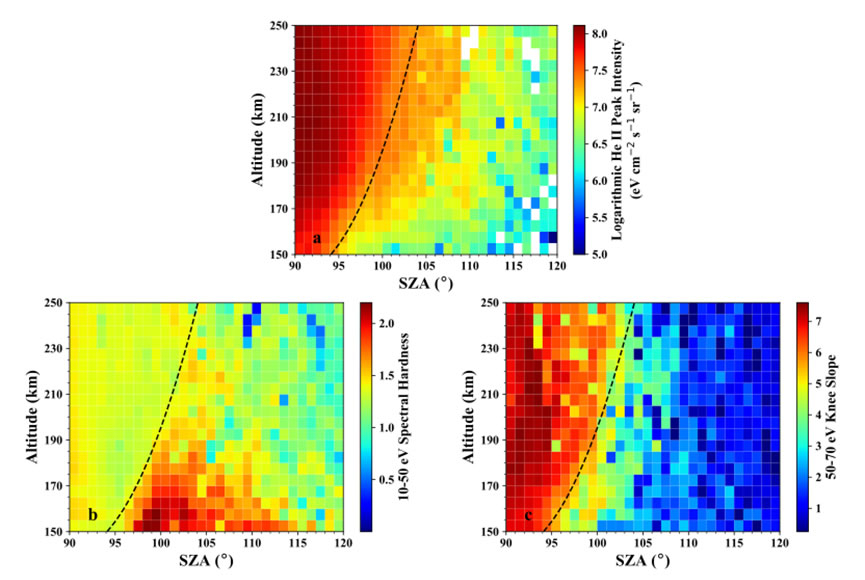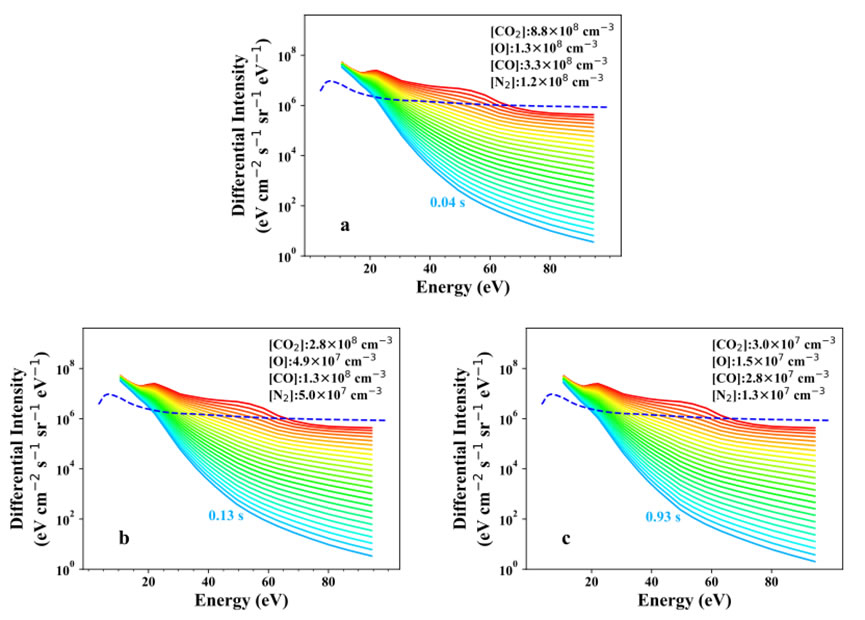The Planetary Environmental and Astrobiological Research Laboratory (PEARL) team discovered the Cross-Terminator Variations of the Photoelectron Energy Distribution in the Martian Ionosphere
In addition to the thermal ions and electrons, suprasternal photoelectrons are also an omnipresent population of the Martian ionosphere. Photoelectrons in the Martian upper atmosphere are of broad interest because by impacting ambient neutrals, they make significant contributions to local ionization, heating, as well as airglow emission. Meanwhile, they could also be used to infer the strength of the ambipolar electric field, which is crucial for evaluating plasma escape on Mars.
Like on the Earth and other terrestrial bodies such as Venus, Titan, and Enceladus, photoelectrons near Mars are the direct products of the solar EUV and X-ray ionization of atmospheric neutrals. Despite exclusively produced on the dayside, photoelectrons have also been frequently observed in the deep nightside as the outcome of cross-terminator photoelectron transport. Photoelectrons have been extensively studied over the past few decades by several dedicated missions such as the Mars Global Surveyor, the Mars Express, and the Mars Atmosphere and Volatile EvolutioN (MAVEN). But existing studies of the nightside photoelectrons mostly focus on their occurrences, the detailed shape of the nightside photoelectron energy distribution has been paid little attention to.
Recently, Yueming Cheng, postgraduate student of the Planetary Environmental and Astrobiological Research Laboratory (PEARL, led by Prof. Jun Cui), School of Atmospheric Sciences, Sun Yat-sen University, published an academic paper entitled "Cross-Terminator Variations of the Photoelectron Energy Distribution in the Martian Ionosphere" in Journal of Geophysical Research: Planets.


The production process leaves prominent features in the electron energy distribution that makes the photoelectron population easily recognizable and distinguishable from other populations of energetic electrons such as the solar wind electrons. Recently, our team proposed that, in addition to the aforementioned spectral characteristics, the broad shape of a typical photoelectron energy spectrum, parameterized as the spectral slope at 10 − 50 eV and denoted hereafter as the “hardness”. Our analysis of a large
MAVEN SWEA data set shows unambiguously that (a) the He II peak becomes less pronounced, (b) the portion of the spectrum at 10 − 50 eV becomes hardened, and (c) the aluminum edge becomes softened, all beyond the EUV terminator (Figure 1). These diverse observations could be understood as a general trend of a highly non-thermal, structured photoelectron energy distribution under sunlit conditions, evolving toward a thermal, featureless one in the darkness, during day-to-night transport.
We carry out simplified calculations based on the approximation of local energy degradation, which adequately demonstrate the role of “atmospheric absorption” in modifying the photoelectron energy distribution beyond the EUV terminator (Figure 2). is unnecessarily inconsistent with the observed SZA extension
of 10° or so, over which the spectral change occurs. Without the implementation of a sophisticated photoelectron transport model, our crude estimates indicate that a field-aligned atmospheric column of ≈1.5 × 1015 cm−2 is required for the e-folding change of a typical photoelectron energy distribution and to accomplish this, a typical
photoelectron could indeed travel a large horizontal distance within the predicted time interval.
This study presents a further investigation of the variation of the photoelectron spectral shape, which sheds more light because the spatial extension of the cross-terminator magnetic connectivity could also be inferred, provided that the three-dimensional distributions of important atmospheric neutrals are known a priori.
Citation:
Cheng, Y.-M., Wu, X.-S., Cui, J., Cao,
Y.-T., Ni, B.-B., & Wei, Y. (2022). Crossterminator variations of the photoelectron
energy distribution in the Martian
ionosphere. Journal of Geophysical
Research: Planets, 127, e2021JE007136.
https://doi.org/10.1029/2021JE007136

